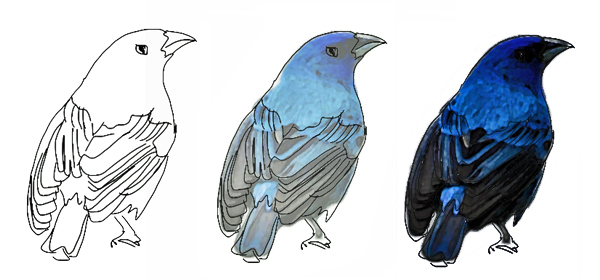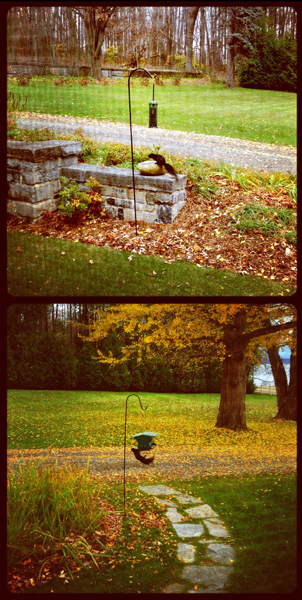
Rather than whining through another verse of the Bali Blues on my harmonica, I awoke on my first morning back at Rosslyn in a fever to jump-start autumn/winter rituals. Top of the list was setting up the bird feeders in anticipation of Adirondack birding. A recent radio report on Vermont Public Radio had mentioned that October through April is the recommended bird feeding season. Sorry birds!
Set up (and filled) bird feeders for fall/winter/spring. Off to a gr8 birding season: bluejays, chickadees, cardinals and indigo bunting.
— virtualDavis (@virtualDavis) November 4, 2012
@virtualDavis that indigo bunting reference if seen definitey deserves an ! after it or a smily icon.birds rule!birding#birdwatching#nature
— Ellen Pober Rittberg (@ellen_rittberg) November 4, 2012
I hasten to add (for the sake of Ellen Pober Rittberg (@ellen_rittberg) and any other seasoned birders who I may have inadvertently mislead) that I’m not 100% certain I saw an indigo bunting. The size and general description in our bird books were spot-on, but the coloration was considerably darker than the flashy blue in the illustrations. And I realize that the beginning of November is late in the migration calendar for an indigo bunting to be spotted this far north. Perhaps this helps?
“It displays sexual dimorphism in its coloration; the male is a vibrant blue in the summer and a brown color during the winter months, while the female is brown year-round.” (Wikipedia)
Either the late date explains the closer-to-blue-black coloration of the bird I spied at the feeders hanging in our ginkgo or else I’ve misrepresented the fancy fellow. (All other suggestions are welcome in the comments below!)
In any case, kamikaze chickadees began dive bombing me while I was installing the bird feeders despite the fact that all four feeders were empty. At first. Until they weren’t. I stuffed them with black oil sunflower seeds. And waited. But the birds were gone! So much for Adirondack birding…
So much for squirrel-proof bird feeders. You've gotta respect our Adirondack "monkeys", no? #rossl @ Rosslyn http://t.co/H4nWLYYV
— virtualDavis (@virtualDavis) November 4, 2012
The squirrels were considerably less bashful, especially this coal black fellow who was totally focused on sunflower seed nirvana all day.

Time for Adirondack squirreling!
Of course, this warmed up the ongoing debate with my bride about the merit of feeding squirrels. Remember our fox and squirrel adventures last year?
I’ve accepted that I’m not making any headway toward convincing my haven-for-wildlife-unless-they’re-predators bride that we should feed songbirds, not squirrels. Perhaps its time to swap Adirondack birding for Adirondack squirreling aspirations? Although, the latter conjures up the image of my bearded, red and black check wool coated, Daniel Boone hat wearing, shotgun toting alter ego trudging through the snow.
I suppose it doesn’t much matter if we feed the birds or the squirrels, especially since the latter inevitably results in considerably wilder window safaris. And yet I still have some misgivings.
The idea started logically enough. Sprinkle excess food on the stone walls, etc. so the squirrels will not try to “rob” food from the bird feeders.
Unfortunately, the squirrel population mushroomed last winter and the songbird population shrank. Are the wee feathered critters intimidated by the squirrels? I suspect the equation is a bit more complicated.
You see in addition to squirrels, my bride’s robust feeding regimen also attracted a healthy host of doves and pigeons. And crows. It seems that the density of big critters discourages the little songbirds, but I’m venturing into the land of brazen hypothesis here. With plenty of plump squirrels and pigeons waddling around, it was only a matter of time before savvy foxes and hawks got wind of the Rosslyn buffet. I suspect that it doesn’t take too many fox attacks and hawk attacks before the songbirds wise up and search for friendlier dining.
Stay tuned for further developments.
In the mean time, I’ll enjoy the abundance of songbirds that have been flocking to our feeders over the past couple of days. And the endless Canada Geese migrating south, many of which stop on Rosslyn’s waterfront to spend the night. There must have been three hundred geese standing along the shoreline and bobbing in the morning waves when I looked out my office window today!
What do you think?